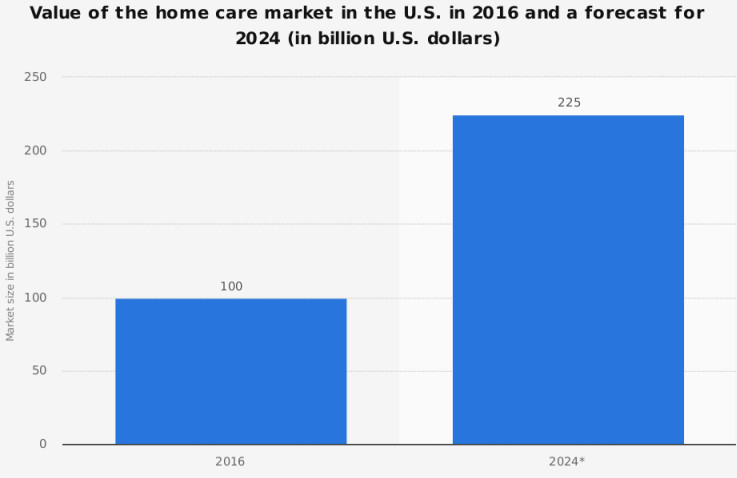Technological advancement is behind the current positive trajectory of the healthcare industry. Previously, the most dominant health systems were hospital care and physician services. However, the availability of technology and changing preferences by the patient pool are enabling the rise of home healthcare as the most preferred health system.
As of 2018, the global home healthcare services industry was worth $261.53 billion, Grand View Research data shows. Between 2019 and 2026, Grand View Research expects the Home Healthcare Services market to register a compound annual growth rate of 7.8%. Another study by Reports and Data, a market intelligence firm, agreed with Grand View Research. According to the study, the global home healthcare services market would expand to $$482.97 billion by 2026, which represents a CAGR of about 7.9%.
Increased adoption of telehealth services and products is fueling the growth of the industry. Notably, patients are finding telehealth to be more convenient and cost-saving. For instance, patients do not have to spend money on admission fees, transport, and facility fees. On the other hand, caregivers and physicians find remote monitoring of a patient’s vitals more effective. It is because they have a large pool of data from which to base their decisions.
In which countries is the industry more robust?
Activity in the home healthcare services is skewed towards countries whose technological capabilities are excellent. Additionally, the market is more robust in countries that have a burgeoning elderly population. With this in mind, the US is the most significant player in the industry, based on the size of the market and the adoption of home healthcare services.
In 2018, a Business Insider Intelligence report noted that the US home healthcare market was worth $103 billion. Interestingly, the same report estimated that the market would be worth $173 billion come 2026, a growth rate that tops other types of care like physician services and hospital care. A separate report by Statista put the value of the US home healthcare services market at $100 billion in 2016. Further, Statista expects the value of the market to expand to $225 billion as of 2024.

The home healthcare services industry is robust in Europe and only second to North America. The United Kingdom, in particular, is the leading market in the region. In 2019, the UK Home healthcare services market was worth $1.19 billion. The market should grow at a CAGR of 6.4% between 2019 and 2026 to reach $1.95 billion.
Sectors where the industry is more significant today?
The home healthcare services industry operates based on two major sectors. First is the therapeutics sector. Here, the services and products are focused on using therapeutics to treat various conditions among patients at home. The therapeutics sector of the home healthcare services industry majorly centers on telemedicine. Some of the largest telemedicine companies worldwide include Doctor On Demand and CareClix. CareClix conducts video examinations of patients and remote consultations.
The other sector is diagnostics services. Companies in this sector focus on providing products that diagnose patients remotely and then send the data to physicians. The physicians use the data to recommend treatment solutions. Doctor On Demand uses videoconferences to diagnose patients. An excellent example of a diagnostic product is OxyGo FIT Connect, a software solution that monitors portable oxygen concentrators that many home-based patients use. The solution is a product of OxyGo LLC.
An outlook of the industry
The rising population of geriatric patients, who make up the larger share of the home healthcare services patient pool, will fuel the growth of the sector. A United Nations report argued that the aging of the population would be “one of the most significant social transformations of the twenty-first century.” People over the age of 65 will make up 16% of the global population by 2050, according to World Population Prospects 2019 data. This demographic is vulnerable to chronic diseases, which are preferably treated at home. Opting for home healthcare services will be the most likely scenario.







